 |
| September 19, 2017 | Volume 13 Issue 35 |
Motion Control News & Products
Designfax weekly eMagazine
Archives
Partners
Manufacturing Center
Product Spotlight
Modern Applications News
Metalworking Ideas For
Today's Job Shops
Tooling and Production
Strategies for large
metalworking plants
Robots think and act on the fly at moving assembly line speeds
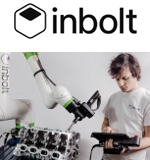 Inbolt and FANUC are launching a manufacturing breakthrough enabling FANUC robots to tackle one of the most complex automation challenges: performing production tasks on continuously moving parts at line speeds. With Inbolt's AI-powered 3D vision, manufacturers can now automate screw insertion, bolt rundown, glue application, and other high-precision tasks on parts moving down the line without costly infrastructure investments or cycle time compromises.
Inbolt and FANUC are launching a manufacturing breakthrough enabling FANUC robots to tackle one of the most complex automation challenges: performing production tasks on continuously moving parts at line speeds. With Inbolt's AI-powered 3D vision, manufacturers can now automate screw insertion, bolt rundown, glue application, and other high-precision tasks on parts moving down the line without costly infrastructure investments or cycle time compromises.
Learn more.
Best high-speed rotary bearing in THK history
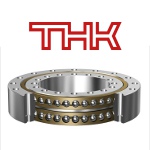 THK has developed its best-performing, high-speed rotary bearing ever: the High-Speed, Double-Row Angular Contact Ring BWH. This rotary bearing has balls aligned inside a cage between the inner and outer rings and is part of the THK Rotary Series, along with the cross-roller ring. The main features of this product are its ability to receive loads in all directions as well as its high rigidity and rotational accuracy, which are equal to that of cross-roller rings. By adopting a new structure to change the rolling elements from rollers to balls, this product achieves the greatest high-speed performance ever offered by THK.
THK has developed its best-performing, high-speed rotary bearing ever: the High-Speed, Double-Row Angular Contact Ring BWH. This rotary bearing has balls aligned inside a cage between the inner and outer rings and is part of the THK Rotary Series, along with the cross-roller ring. The main features of this product are its ability to receive loads in all directions as well as its high rigidity and rotational accuracy, which are equal to that of cross-roller rings. By adopting a new structure to change the rolling elements from rollers to balls, this product achieves the greatest high-speed performance ever offered by THK.
Learn more.
Elevating tables: Precise vertical positioning in tight spaces
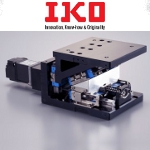 As semicon-ductors and optical components become smaller and more sophisticated, the TZ Series of precision elevating tables from IKO International provides exceptional vertical positioning accuracy in a compact size. This unit features a unique wedge mechanism guided in the vertical direction by a pair of IKO C-Lube Super MX linear motion rolling guides arranged in parallel to achieve highly precise positioning with exceptional rigidity. An optional linear encoder provides full closed loop control to achieve positioning accuracy as high as 0.005 mm, with repeatability of +/-0.001 mm.
As semicon-ductors and optical components become smaller and more sophisticated, the TZ Series of precision elevating tables from IKO International provides exceptional vertical positioning accuracy in a compact size. This unit features a unique wedge mechanism guided in the vertical direction by a pair of IKO C-Lube Super MX linear motion rolling guides arranged in parallel to achieve highly precise positioning with exceptional rigidity. An optional linear encoder provides full closed loop control to achieve positioning accuracy as high as 0.005 mm, with repeatability of +/-0.001 mm.
Learn more and get all the specs.
This cobot is all about safety around people
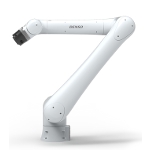 The COBOTTA PRO from DENSO Robotics is a lightweight, high-speed collaborative robot designed for communication between workers and robots while maximizing productivity. It delivers a blend of productivity and safety for both simple tasks and multi-step processes like assembly and inspection work. The 6-axis unit operates at speeds up to 2,500 mm per sec when no workers are near and slows or stops when people approach. Two models available: PRO 900 (max payload 6 kg) and PRO 1300 (max payload 12 kg). Many more functions and features.
The COBOTTA PRO from DENSO Robotics is a lightweight, high-speed collaborative robot designed for communication between workers and robots while maximizing productivity. It delivers a blend of productivity and safety for both simple tasks and multi-step processes like assembly and inspection work. The 6-axis unit operates at speeds up to 2,500 mm per sec when no workers are near and slows or stops when people approach. Two models available: PRO 900 (max payload 6 kg) and PRO 1300 (max payload 12 kg). Many more functions and features.
Learn more.
Powerful, pull-type clapper solenoids handle myriad jobs
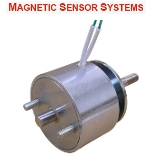 New powerful, low-profile, pull-type clapper solenoids are available from Magnetic Sensor Systems (MSS). Applications include valve control, locks, starters, ventilators, clamping, sorting, appliances, tools, HVAC, brakes, clutches, switches, mixing, fire suppression systems, door controls, detent latches, and more. The S-16-264 Series of 17 Pull-Type Clapper Solenoids have ampere turns (windings) adjusted to meet the specific force and duty cycle requirements of your application. They provide up to 130 lb (578 N) of force.
New powerful, low-profile, pull-type clapper solenoids are available from Magnetic Sensor Systems (MSS). Applications include valve control, locks, starters, ventilators, clamping, sorting, appliances, tools, HVAC, brakes, clutches, switches, mixing, fire suppression systems, door controls, detent latches, and more. The S-16-264 Series of 17 Pull-Type Clapper Solenoids have ampere turns (windings) adjusted to meet the specific force and duty cycle requirements of your application. They provide up to 130 lb (578 N) of force.
Get all the specs for these solenoids and other options.
Tech Tip: Belt, screw, or chain-driven actuator?
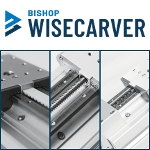 Bishop-Wisecarver provides a quick, very useful guide to help you evaluate the right drive strategy for your system: belt, screw, or chain-driven actuator. Each drive type has unique advantages and limitations, so evaluating all your options will help you find the most suitable actuator setup for your specific application needs.
Bishop-Wisecarver provides a quick, very useful guide to help you evaluate the right drive strategy for your system: belt, screw, or chain-driven actuator. Each drive type has unique advantages and limitations, so evaluating all your options will help you find the most suitable actuator setup for your specific application needs.
Read the Bishop-Wisecarver blog.
Ultra-precise linear stage -- down to 0.005 microns
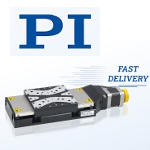 PI, a global leader in precision motion control and nanoposi-tioning, now offers fast delivery of the L-511 linear micropositioning stage, which is designed for applications requiring minimum incremental motion down to 20 nm, drive forces up to 22 lb, and multi-axis configuration options. The L-511 can be combined to form XY or XYZ motion systems and integrated with rotary stages. A variety of drive and encoder options (stepper and servo motors, rotary, and linear encoders) enable ultra-fine sensitivity. Applications include: metrology, laser processing, semiconductors, biotech, optical alignment, and advanced automation.
PI, a global leader in precision motion control and nanoposi-tioning, now offers fast delivery of the L-511 linear micropositioning stage, which is designed for applications requiring minimum incremental motion down to 20 nm, drive forces up to 22 lb, and multi-axis configuration options. The L-511 can be combined to form XY or XYZ motion systems and integrated with rotary stages. A variety of drive and encoder options (stepper and servo motors, rotary, and linear encoders) enable ultra-fine sensitivity. Applications include: metrology, laser processing, semiconductors, biotech, optical alignment, and advanced automation.
Learn more and get all the specs.
Choosing the right stepper motor: PM or hybrid?
 According to the experts at Lin Engineering, there are two primary types of stepper motors to consider: permanent magnet (PM) and hybrid. But which is right for your application? Both types have their advantages and disadvantages, and the choice ultimately depends on your specific requirements.
According to the experts at Lin Engineering, there are two primary types of stepper motors to consider: permanent magnet (PM) and hybrid. But which is right for your application? Both types have their advantages and disadvantages, and the choice ultimately depends on your specific requirements.
Read this informative Lin Engineering article.
New PTFE-free linear guide for precise positioning
 The new drylin WWP linear guide from igus features a PTFE-free locking carriage. Engineered from lubrication-free, high-performance polymers and aluminum, the guide offers a lightweight, hygienic, and low-maintenance alternative to complex mechanical and electronic adjustment systems. It is significantly more compact and lightweight than conventional recirculating ball-bearing systems. Applications include interior components in vehicles, aircraft, and furniture.
The new drylin WWP linear guide from igus features a PTFE-free locking carriage. Engineered from lubrication-free, high-performance polymers and aluminum, the guide offers a lightweight, hygienic, and low-maintenance alternative to complex mechanical and electronic adjustment systems. It is significantly more compact and lightweight than conventional recirculating ball-bearing systems. Applications include interior components in vehicles, aircraft, and furniture.
Learn more and get all the specs.
Heavy-duty gear units for mixing and agitating systems
 MAXXDRIVE industrial gear units from NORD DRIVE-SYSTEMS are an established drive solution for heavy-duty applications. In addition to conveying, lifting, and driving, they also play an important role in mixing and agitating systems. MAXXDRIVE units feature a compact, one-piece UNICASE housing that delivers long service life, easy maintenance, and quiet operation. Their robust design handles high axial and radial loads, achieves output torques up to 2,495,900 lb-in., and powers up to 8,075 hp.
MAXXDRIVE industrial gear units from NORD DRIVE-SYSTEMS are an established drive solution for heavy-duty applications. In addition to conveying, lifting, and driving, they also play an important role in mixing and agitating systems. MAXXDRIVE units feature a compact, one-piece UNICASE housing that delivers long service life, easy maintenance, and quiet operation. Their robust design handles high axial and radial loads, achieves output torques up to 2,495,900 lb-in., and powers up to 8,075 hp.
Learn more.
What are non-captive linear actuators?
 According to PBC Linear, their new non-captive linear actuators are different from the more common external versions of lead screw-driven linear actuators because they allow the lead screw to completely pass through the motor. This fundamental difference offers advantages for designs that have limited space available or for engineers looking to shrink the overall size of their design package.
According to PBC Linear, their new non-captive linear actuators are different from the more common external versions of lead screw-driven linear actuators because they allow the lead screw to completely pass through the motor. This fundamental difference offers advantages for designs that have limited space available or for engineers looking to shrink the overall size of their design package.
Read the full PBC Linear blog.
Güdel introduces Swiss-quality tracks for cobots
 Güdel Inc. is highlighting new technologies at Automate 2025 booth #2418 that demonstrate its unmatched ability to solve automation engineering challenges. One is the Cobomover, a 7th-axis linear track purpose-built for collaborative and lightweight robots. Designed and manufactured in Switzerland, this unit extends the working range of robots up to 5 m, allowing them to operate multiple workstations and perform a variety of tasks without manual repositioning. Compatible with over 60 cobots and small traditional robots.
Güdel Inc. is highlighting new technologies at Automate 2025 booth #2418 that demonstrate its unmatched ability to solve automation engineering challenges. One is the Cobomover, a 7th-axis linear track purpose-built for collaborative and lightweight robots. Designed and manufactured in Switzerland, this unit extends the working range of robots up to 5 m, allowing them to operate multiple workstations and perform a variety of tasks without manual repositioning. Compatible with over 60 cobots and small traditional robots.
Learn more and get all the specs.
New open-center XYZ stage
 ThruSight-Focus is a high-performance, compact motion platform specifically engineered for applications requiring dual-side access to the sample or workpiece. It pairs ALIO's monolithic open-center XY stage -- known for its nanometer-level precision, crossed roller bearings, and direct linear drives -- with a novel Z-wedge mechanism that converts horizontal drive force into vertical motion via direct drive. This innovative architecture eliminates backlash, enhances servo responsiveness, and delivers fast, stable Z-axis movements -- all within a low-profile footprint.
ThruSight-Focus is a high-performance, compact motion platform specifically engineered for applications requiring dual-side access to the sample or workpiece. It pairs ALIO's monolithic open-center XY stage -- known for its nanometer-level precision, crossed roller bearings, and direct linear drives -- with a novel Z-wedge mechanism that converts horizontal drive force into vertical motion via direct drive. This innovative architecture eliminates backlash, enhances servo responsiveness, and delivers fast, stable Z-axis movements -- all within a low-profile footprint.
Learn more.
Eaton unveils differential engineered for EVs
 Intelligent power management company Eaton launched a new differential engineered specifically for electric vehicles at Auto Shanghai 2025 in China. The innovative design addresses the unique challenges presented by EV propulsion systems, including shared low-viscosity oil environments, increased sensitivity to noise, and the demands of high and instant torque delivery.
Intelligent power management company Eaton launched a new differential engineered specifically for electric vehicles at Auto Shanghai 2025 in China. The innovative design addresses the unique challenges presented by EV propulsion systems, including shared low-viscosity oil environments, increased sensitivity to noise, and the demands of high and instant torque delivery.
Read the full article.
Top Product: Integrated servo system is 20% smaller than standalone unit
 Applied Motion Products has introduced the MDX+ series, a family of low-voltage servo systems that integrate a servo drive, motor, and encoder into one package. This all-in-one drive is an ideal solution for manufacturers in logistics, AGV, medical, semiconductor, the solar industries, and many others.
Applied Motion Products has introduced the MDX+ series, a family of low-voltage servo systems that integrate a servo drive, motor, and encoder into one package. This all-in-one drive is an ideal solution for manufacturers in logistics, AGV, medical, semiconductor, the solar industries, and many others.
Read the full article.
Navy deep-sea sensor systems try to find a better way to forecast hurricane strength

A GOES satellite image taken Sept. 7, 2017, at 8:45 a.m. EST shows Hurricane Irma, center, and Hurricane Jose, right, in the Atlantic Ocean, and Hurricane Katia in the Gulf of Mexico. [U.S. Navy photo/Released. Photo by Oscar Sosa, Navy Media Content Services]
By Warren Duffie Jr., Office of Naval Research
As Hurricane Irma approached U.S. shores, researchers sponsored by the Office of Naval Research (ONR) were using air-dropped autonomous sensors to compile real-time ocean observations to help forecasters predict the strength of future tropical storms.
This marks the first time the sensors -- called ALAMO (Air-Launched Autonomous Micro Observer) sensors -- were used in hurricane-prediction research. While standard computerized prediction models rely on atmospheric data like air temperature, humidity, altitude, and wind speed and direction, the ALAMO sensors (sponsored by ONR) measure oceanographic phenomena beneath the sea surface.

Members of the ONR-sponsored research team prepare to drop ALAMO sensors. [U.S. Navy photo/Released]
"Hurricanes like this have a devastating impact on coastal regions, and our thoughts and prayers are with the affected communities," said Chief of Naval Research Rear Adm. David J. Hahn. "Often, there is an intersection of military and civilian needs. If we can improve the lead time and accuracy of storm forecasts, it would give national and local leadership more time and detailed information for preparations, evacuation, or shelter-in-place decisions."
Fully developed tropical cyclones -- called hurricanes or typhoons, depending on their region -- can grow as wide as several hundred miles and sustain winds greater than 150 mph. With historically high winds, Hurricane Irma was one of the strongest storms ever recorded in the Atlantic Ocean.
Such storms are notoriously difficult to predict, presenting a volatile meteorological cocktail that can change direction, speed, and strength -- quickly and unexpectedly. One reason is that current forecasting models focus on the atmosphere instead of the underwater properties that contribute to the creation of hurricanes, which are difficult to observe.
In addition to the potential catastrophic damage to coastal communities, hurricanes also pose a severe threat to U.S. Navy fleet operations. Accurate forecasting is critical for protecting ships at sea, evacuating vulnerable bases, and performing humanitarian assistance and disaster relief.

The new ALAMO sensor bests previous Navy float sensors in that it can measure 1,000 temperature profiles in a deployment and can directly measure pressure (a proxy for depth). Previous solutions used fall-rate equations to calculate depth.
When Hurricane Irma was headed for U.S. landfall, the ONR-sponsored research team, composed of U.S. Naval Academy midshipmen and scientists from Woods Hole Oceanographic Institution, dropped 10 ALAMO sensors from an Air Force C-130 "Hurricane Hunter" aircraft into Caribbean waters off the coast of Florida, ahead of the storm. The sensors were also used to track ocean dynamics in Hurricane Jose.
Short, metal tubes crammed with sensors and scientific instruments, each ALAMO sensor sank nearly 1,000 ft underwater and then rose again. They've been tracking ocean temperature, salinity, and pressure, and then transmitting this data via satellite for use by the Naval Research Laboratory to update the Navy's coupled ocean-atmosphere forecasting models.
"The ALAMO sensors will enable us to get an accurate picture of conditions in the water column -- before, during, and after a hurricane," said Capt. Elizabeth Sanabia, an oceanography professor at the Naval Academy, who is overseeing the research. "For the Navy, this improved forecasting will increase operational readiness and mitigate risk. For the nation, it will result in better response planning and potentially save lives."
The participating Naval Academy midshipmen were Casey Densmore, Kelli Wise, and Rachel Boushon.
Now that Hurricane Irma has passed, the information accumulated by Sanabia's team will be used to improve the Navy's Coupled Ocean/Atmosphere Mesoscale Prediction System-Tropical Cyclone -- COAMPS-TC, for short. COAMPS-TC, developed with ONR support, uses complex algorithms to predict hurricane intensity by processing real-time and historical meteorological data, fed by information from satellites.
"Our goal is to improve ocean and atmosphere modeling and prediction for fleet operations," said Dr. Ronald Ferek, a program manager in ONR's Ocean Battlespace Sensing Department. "The real-time COAMPS-TC forecasts for Hurricane Irma help the Navy issue operational guidance for fleet safety and improve understanding of the complex air-sea interaction processes that drive the intensity of tropical hurricanes."
ONR's sponsored hurricane research is part of the Task Force Ocean initiative, which seeks to strengthen the Navy's oceanographic capabilities in ocean sensing and modeling technology.
Published September 2017
Rate this article
View our terms of use and privacy policy

